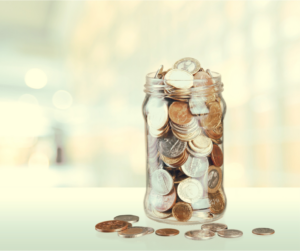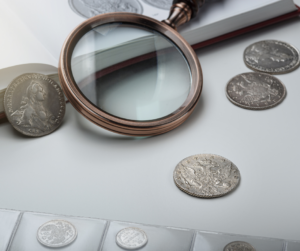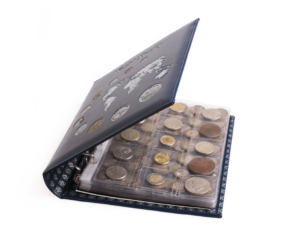
Ten years ago, a family turned to Ian Russell when they discovered that their grandmother was not telling tales when she talked about a valuable coin she had bought years before.
“She always talked about this coin and how it would be valuable by the time they inherited it,” recalls Russell who is president of GreatCollections Coin Auctions. “But the family knew nothing about it, and they could never find it – they thought she was crazy.”
The family explained that in the 1960s their grandmother had squirreled away a portion of her salary as a secretary for the U.S. Central Intelligence Agency (CIA) for six months to spend $225 on an 1842-O Liberty Gold Eagle coin that she expected to become valuable someday. “Somebody had told her to invest in one valuable coin and hang on to it,” Russell explains. “When she passed away, the family finally found the coin, and it brought $52,700 when we sold it at auction.”

Inherited Coins
According to Russell, the tale is not an unusual one – in fact, it’s one he hears all the time.
“We get calls every day from people who are in that position – people who inherit a coin or a collection from a relative,” he says. “Sometimes the collector leaves instructions for the family, sometimes not – sometimes the collection is worth thousands of dollars; sometimes not.”
According to Marketwatch, a website that offers financial information including analysis and stock market data, between seven and 10 million Americans collect coins, either seriously or as amateurs. “In the U.S. almost everybody has a story about an uncle or a father or a brother who collects coins,” Russell says. Of those, 90 percent are men. “That used to be 99 percent, but since the COVID pandemic more women became involved,” he says.
Striking Interest
Before the pandemic ever became a factor, it was the U.S. Mint’s issue of its series of quarters featuring scenes from all 50 states that is largely credited with introducing Americans to coin collection in the first place. “Some coin collectors got involved in 1999 when the mint released the state quarter coins,” Russell said. “For some of those people coin collecting became a lifelong hobby.”
And as those lifelong coin collectors began to pass away, their collections – or at least parts of them – were willed to family members and others who were subsequently faced with the decision to keep the coins or sell them as assets.
Deciding What’s Valuable
To do that, they first have to decide which coins are worth keeping and which are valuable assets. According to CoinAge magazine executive editor Scott Travers, making that decision should always begin with doing a little research. “The first thing people should do is get educated,” Travers advises.
Travers advises people to peruse their collection and consult the Professional Coin Grading Service (PCGS) Price Guide to get an idea of each coin’s value in the marketplace. The guide lists prices that represent average dealer asking prices for PCGS-graded coins. Those prices are compiled from a range of sources including dealer-sponsored advertisements in trade papers, dealer fixed price lists, dealer website offerings, auctions and activity at auctions.
Grading Coins
Next, based on information gleaned from the guide, Travers recommends that new owners have the coins that they believe are valuable graded.
Grading takes place when a third, independent party views the coin in person and evaluates based on strength of strike, wear, contact marks and eye appeal. On that basis, coins are assigned a number between 1 and 70 with 70 being flawless.
Once the coin is assigned a grade, it is put into a sonically sealed protective core holder and affixed with a label that lists its date, denomination, mintmark, grade, variety, and designation and given an individual identification number.
According to Travers, the California-based Professional Coin Grading Service (PCGS) and the Numismatic Guaranty Company (NGC) headquartered in Sarasota, Florida, are the most trusted grading companies in the numismatic industry. The Certified Acceptance Corporation (CAC) verifies coins that have been previously graded and marks those with a unique sticker.
The process can be pricey. “It can cost between $20 and $200 to have a coin graded,” Russell says. The higher the grade, the more the coin is worth because potential collector buyers will pay more for coins in higher grades.

Shop Around
Once they have an idea about what the inherited coins are worth, heirs should shop around for a reputable outlet that can sell the coins for them if that’s what they want to do.
Travers advises scouring the internet for reputable dealers most of whom belong to professional associations including the American Numismatic Association or the Professional Numismatics Guild (PNG). Both organizations list a directory of member dealers on their websites.
Heirs may also take the coins to a local dealer. Either way, Russell recommends that they choose among possible dealers carefully and consider selling their coins at auction.
According to Russell, dealers who purchase coins outright frequently want to buy coins as inexpensively as possible to realize the highest profit from them. By contrast, reputable auctioneers don’t have that kind of skin in the game. “Auction houses don’t have a conflict of interest,” he says.
Whatever they choose, getting more than one opinion of the coin’s value is key.
“Get multiple opinions,” Russell recommends. “Sooner or later, you’re going to find someone you feel comfortable with.”
What to Keep & What to Sell
After that, it is up to the heirs to decide if they want to divest the collection completely or keep a portion of it for investment or as a legacy from their benefactor. “Some people just want an evaluation because they want to know what to put on the (estate) tax return,” he explains. “But we’ve had situations where two or three of the heirs wanted to sell, and one situation where the family wanted to sell 99 percent of the valuable coins and split the proceeds and hold on to one percent to keep as a remembrance of the person that passed away.”
At that point, the heirs or their lawyers must decide what to do with the collection – especially one that they may not have had any idea even existed.
“A lot of people have a whole life interest (in coin collecting) that no one else in the family knows about,” Russell says. “In the end, some people are sorry to find out that their family member did not talk more about his coin collection.”
What’s in your Coin Jar?
Not everyone has a coin inheritance, but just about everybody has a jar, a coffee can or some other container where they put loose change.
It does not take long to accumulate enough pennies, dimes, nickels or quarters to make the container nearly too heavy to lift, but before cashing the coins at the local bank or coin-counting kiosk, a person has to wonder if some valuable treasure might be lurking in that otherwise mundane batch of pocket change.
That’s the question asked most often to coin expert and consultant Mike Fuljenz’ during his monthly radio talk show in southwest Texas. “Absolutely the most often asked question concerns coins saved over the years in various containers and if any have value,” recalls Fuljenz who is president of Universal Coin and Bullion in Beaumont, Texas. “In truth, rarely does someone find a valuable coin in circulation – really valuable coins in collections were typically bought from a coin dealer or a coin auction.”
But it does happen – and that’s why Fuljenz recommends that before cashing them in, a good sift through those coins is key. “I looked through thousands of coins as a motivated kid and the only valuable coins I found in circulation were dimes, quarters and halves dated 1964 and before, 1965-1969 Kennedy half dollars that have 40% silver, 1942-1945 war nickels that are 35% silver and 1943 Zinc coated steel pennies,” Fuljenz says.

Quarters & Nickels & Dimes
As of March 1, 2023, larger dealers pay 14 to 16 times face value for dimes, quarters and half dollars dated 1964 and before.
Meanwhile, they pay five to six times face value for 1965-1969 Kennedy half dollars dated 1965-1969, and they pay 80 cents each for average circulated war nickels minted between 1942 and 1945. Some dealers pay as much as 10 cents each for average circulated 1943 steel pennies. “For example, if a dealer pays 15 times face value for your two 1964 Kennedy half dollars, you would get paid $15 for the pair,” Fuljenz says.
According to Fuljenz, those coins represent about 99 percent of the valuable coins found in change. “To get really lucky and find a better date rarity, buy A Guidebook of U.S. Coins also known as The Official Red Book to assist with identifying valuable coins,” he recommends.
Digging for Dollars
Fuljenz talk show callers also frequently wanted to know about the value of the silver dollars they find, specifically Morgan dollars and Peace dollars.
According to Fuljenz, Morgan dollars were made from 1878-1921 and Peace dollars were minted from 1921-1935. They are 90 percent silver and worth $25 or more. They are generally no-shows in typical coin jars, though.
“These are never found in change today but often in containers of coins left to children by their parents or grandparents,” Fuljenz points out.
About those Pennies
According to a 2011 report by the U.S. Mint – it costs about 2.1 cents to make a penny with 1.8 cents going toward producing the coin, 0.26 cents covering administrative costs and 0.003 cents used to distribute the penny to Reserve Banks.
Thanks mainly to the costs of producing and distributing them, pennies which today are most likely to show up in pocket change, are the coins most likely to disappear from the circulation scene soon.
“I think (the U.S.) will (establish) rounding like other countries do including Canada,” Fuljenz predicts. “In fact, we could save many millions by getting rid of pennies.”
This article about coin jar inheritance previously appeared in COINage magazine. To subscribe click here. Article by Pat Raia.












